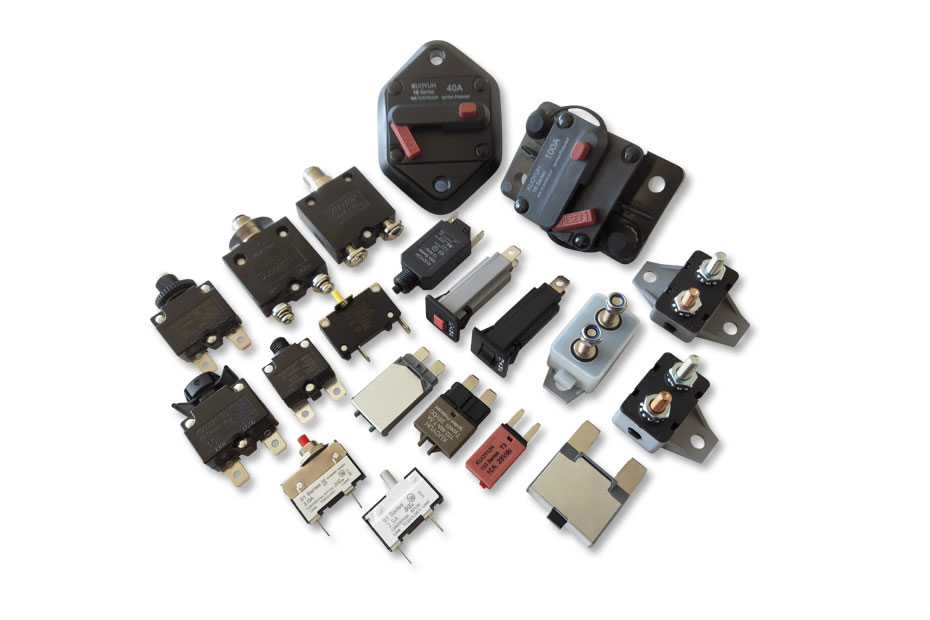Complete Guide to Trailer Winch Circuit Breaker Selection: A Must-Read for DIY Enthusiasts
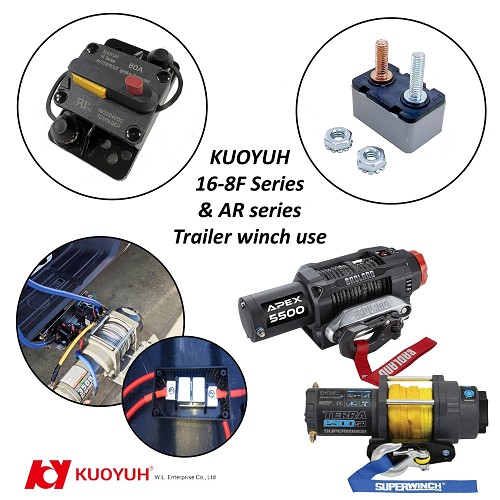
How to Build a Safer and More Stable Trailer Power System with KUOYUH Circuit Breakers
The Real Pain Points of DIY Trailer Owners:
Why Does the Winch Always Have Problems?
For those who frequently tow boats, camp, or go off-road, a winch is an indispensable piece of equipment.
However, many users often face the same frustrating issues:
- • The winch trips power instantly or drains the battery in seconds
- • Wires become hot or even start to smoke
- • Fuses blow and must be replaced
- • The system suddenly stops working mid-use
According to multiple real-world discussions (Expedition Portal, Yesterday’s Tractor Forum, Trailer Sailer Place), the common causes include:
- • No circuit breaker or protection device → instant wire burn during a short circuit
- • Incorrect wire gauge → voltage drop leading to reduced motor torque
- • Improper fuse design → startup current surge causes nuisance blows
- • Poor grounding / chassis-only return → unstable current and heat spots
“Voltage drop kills motors and batteries. Heavy-duty cables may be a pain, but they save your gear.” — Trailer Sailer Place Forum
All these experiences point to one truth: Proper electrical protection design for your trailer winch is more important than you think.
Why Use KUOYUH Circuit Breakers?
Most DIY users rely on fuses, but fuses are single-use. Once blown, they must be replaced—very inconvenient during outdoor use.
KUOYUH circuit breakers offer a smarter solution: They trip during overload and automatically or manually reset after cooling, with no need for replacement.
Advantages of KUOYUH:
| Feature | KUOYUH Circuit Breaker | Traditional Fuse |
| Overload Protection | Automatic trip & resettable | Blows permanently |
| Lifespan | Over 10,000 cycles | One-time use |
| Rated Current Range | 10A–300A | Depends on fuse type |
| DIY Installation | Manual / Auto reset | Requires replacement |
| Maintenance | Press to reset | Must replace fuse |
| Safety | Time-delay & vibration-resistant | Prone to false trips & heat damage |
KUOYUH products are certified by UL and SAE J553 and are OEM-approved components for trailer, marine winch, and RV power systems worldwide.
KUOYUH Two Key Series: 16-8F vs AR
Both models are popular among DIY trailer and off-road enthusiasts, differing mainly in operation mode, installation style, and application flexibility.
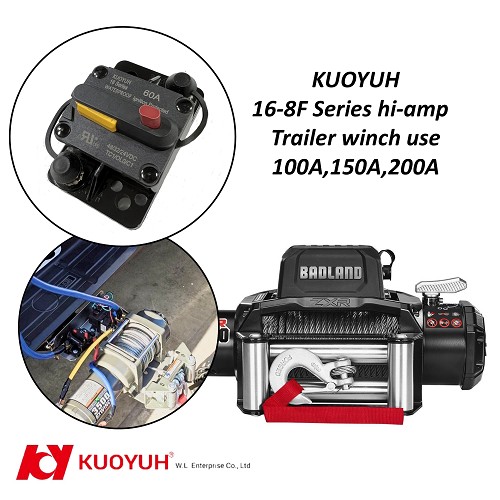
KUOYUH 16-8F Series — Manual Reset Type III+Switch
Features:
- • Panel-mount design can serve as the main power switch
- • Trips under overload and resets with a simple press
- • Passed IP67 waterproof and ignition-protection tests—ideal for outdoor trailers
- • Current range: 25 A – 300 A
- • Certified by UL and SAE J553
Typical Applications:
- • Main winch power circuit
- • Camper trailer master power switch
- • Dual-battery selector systems
- • Marine control panels
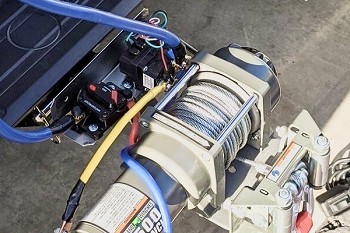
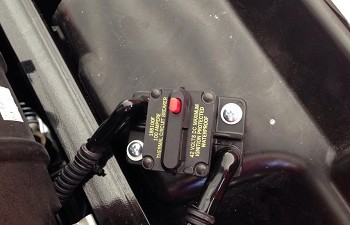
Installation picture examples of the KUOYUH 16-8F series for trailer winch.
Professional Tip:
Choose the 16-8F Series heavy duty winch circuit breaker if you want manual control over the entire system power or prefer a breaker that doubles as a main ON/OFF switch.
It can be mounted on the trailer control panel; the manual reset allows instant recovery on-site—perfect for users who need frequent operation or clear power control feedback.
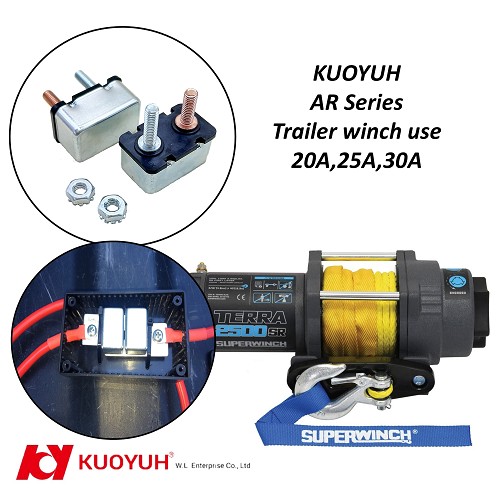
KUOYUH AR Series — Automatic Reset Type I
Features:
- • Compact size for flexible installation
- • Automatic reset function: trips during overload, then restores after cooling
- • Ideal for tight spaces or continuous-power applications
- • Current range: 5 A – 50 A
- • Certified to SAE J553
Typical Applications:
- • Small trailer winches
- • In-vehicle battery protection
- • Custom power modules
- • 12 V sockets and lighting circuits
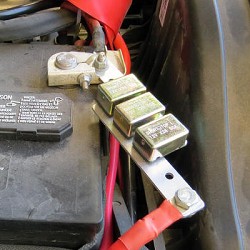
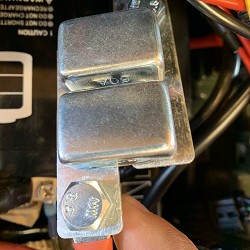
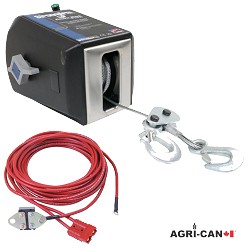
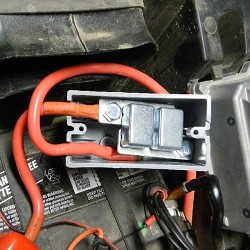
Professional Tip:
Select the AR Series auto reset circuit breaker if your system doesn’t require frequent manual control and you want a maintenance-free, hidden protection setup.
Best installed near the battery or relay, it disconnects automatically under overload and restores power after cooling—ideal for DIY users who want continuous, self-recovering protection.
How to Choose the Right Amperage: Don’t Just Look at Rated Current!
A winch’s startup current can spike 2–3 times higher than its rated value.
When selecting a breaker, always account for surge current and time-delay characteristics.
Current Estimation Formula:
Current (A) ≈ Power (W) ÷ Voltage (V)
| Winch Type | Rated Power | Estimated Current | Recommended Breaker |
| Small Winch (600W / 12V) | ≈ 50A | 40–50A | AR Series |
| Medium Winch (1000W / 12V) | ≈ 83A | 60–80A | 16-8F Series |
| Heavy Winch (1500W / 12V) | ≈ 125A | 100–120A | 16-8F Series |
“Always allow 1.2–1.5× margin above rated current when sizing circuit breakers.”——Expedition Portal Forum
Wire and Grounding Planning:
Thin Wires — The Hidden Killer of Trailer Power Systems.
Forum discussions repeatedly emphasize: Wire gauge and length matter more than brand.
Key principles:
- • Thicker wire is safer — Use at least #6 AWG for high-current winches. “Voltage drop kills motors and batteries.
- • Keep wires short — long cables increase voltage drop and heat loss.
- • Do not rely solely on chassis ground — Place a breaker between the battery positive and the winch to prevent arcing or wire burn.
- • Add a relay or battery isolator between the tow vehicle and trailer battery to prevent reverse discharge.— Install a 20–30 A breaker to stop back-feeding and protect the tow vehicle’s circuit.” — Yesterday’s Tractor Forum
Recommended Wiring Layout (Visual Guide Suggested)
- Battery positive → KUOYUH breaker → Winch positive
- Winch negative → Battery negative (separate return, not chassis)
- Dual-battery system → add relay isolator + secondary breaker
- Camper trailer → add one more 16-8F on the control panel as the main switch
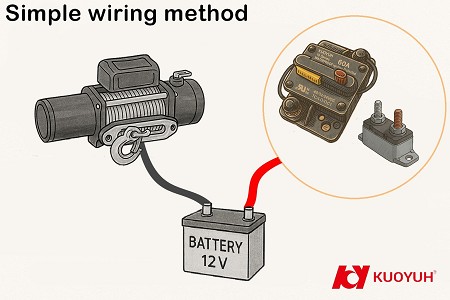
Frequently Asked Questions (FAQ)
Q1: Why use a circuit breaker?
A: To protect wiring and battery safety. When an overload or a short circuit occurs, the breaker instantly trips to prevent melting or fire.
Q2: What amperage should I choose?
A: Select 20–30% higher than your winch’s rated current (e.g., 50 A winch → 60 A breaker).
Q3: Can I just use a fuse?
A: Possible, but not recommended. A fuse blows once and must be replaced; a breaker can reset and be used for years.
Q4: What if my wires are too thin?
A: You’ll get voltage drop, reduced winch power, and risk overheating or false tripping
Q5: Can I use the vehicle chassis as ground?
A: Not recommended unless the ground contact is clean and secure—poor ground causes instability and corrosion.
Q6: Can the trailer battery discharge back into the tow vehicle?
A: Yes. Use a relay or isolator plus a breaker to prevent reverse current.
Q7: What’s the difference between 16-8F and AR Series?
A: 16-8F is manual reset with ON/OFF control for main power; AR is auto reset for compact, hidden, continuous protection.
Conclusion: Make Safety a Standard Feature of Your Trailer
Installing a winch is not enough—proper current protection design is the key to a stable and safe trailer system.
As a professional Taiwanese manufacturer of circuit breakers, KUOYUH has over 30 years of experience exporting to the U.S., Europe, and Australia.
Certified by UL and SAE J553, KUOYUH products are widely used in:
- • Trailer winches
- • Camper trailers
- • Marine power systems
- • RV battery modules
- • Solar power kits
KUOYUH 16-8F and AR Series — turn your trailer from “working” to “working safely and reliably.



